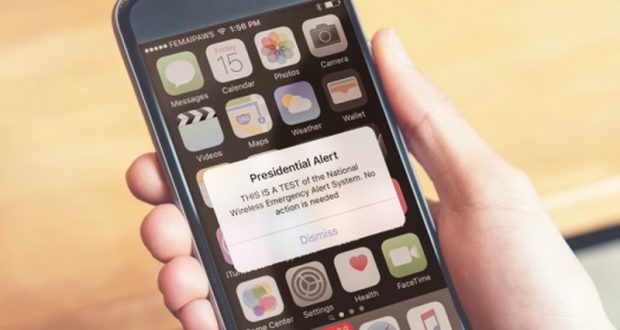WASHINGTON, D.C. – The Federal Emergency Management Agency (FEMA), in coordination with the Federal Communications Commission (FCC), will conduct a nationwide test of the Wireless Emergency Alerts (WEA) and Emergency Alert System (EAS) on Wednesday, Oct. 3.
The WEA portion of the test commences at 11:18 a.m., and the EAS portion follows at 11:20 a.m. The test will assess the operational readiness of the infrastructure for distribution of a national message and determine whether improvements are needed.
The WEA test message will be sent to cell phones that are connected to wireless providers participating in WEA. This is the fourth EAS nationwide test and the first national WEA test. Previous EAS national tests were conducted in November 2011, September 2016, and September 2017 in collaboration with the FCC, broadcasters, and emergency management officials in recognition of FEMA’s National Preparedness Month.
Cell towers will broadcast the WEA test for approximately 30 minutes beginning at 11:18 a.m. During this time, WEA compatible cell phones that are switched on, within range of an active cell tower, and whose wireless provider participates in WEA should be capable of receiving the test message.
Some cell phones will not receive the test message, and cell phones should only receive the message once.
The WEA test message will have a header that reads “Presidential Alert” and text that says: “THIS IS A TEST of the National Wireless Emergency Alert System. No action is needed.”
The WEA system is used to warn the public about dangerous weather, missing children, and other critical situations through alerts on cell phones. The national test will use the same special tone and vibration as with all WEA messages (i.e. Tornado Warning, AMBER Alert). Users cannot opt out of receiving the WEA test.
The EAS is a national public warning system that provides the President with the communications capability to address the nation during a national emergency. The test is made available to EAS participants (i.e., radio and television broadcasters, cable systems, satellite radio and television providers, and wireline video providers) and is scheduled to last approximately one minute. The test message will be similar to regular monthly EAS test messages with which the public is familiar. The EAS message will include a reference to the WEA test:
“THIS IS A TEST of the National Emergency Alert System. This system was developed by broadcast and cable operators in voluntary cooperation with the Federal Emergency Management Agency, the Federal Communications Commission, and local authorities to keep you informed in the event of an emergency. If this had been an actual emergency an official message would have followed the tone alert you heard at the start of this message. A similar wireless emergency alert test message has been sent to all cell phones nationwide. Some cell phones will receive the message; others will not. No action is required.”
Click here for more information and to view the Fact Sheet.
Frequently Asked Questions
What is the Integrated Public Alert and Warning System (IPAWS)?
IPAWS is a national system for local alerting. It provides the means for disseminating authenticated emergency alert and warning messaging from emergency officials to the public through:
- Radio and television via EAS;
- Wireless phones via WEA;
- NOAA All Hazards Weather Radio via IPAWSNOAA gateway; and
- Internet applications and websites via the IPAWS Alerts Feed.
Why does the FEMA IPAWS program conduct national tests of public alert and warning systems?
The IPAWS Modernization Act of 2015 (Public Law 114-143) requires the FEMA IPAWS Program Management Office (PMO) to conduct, not less than once every three years, a nationwide test of the public alert and warning system. The Act, which became law in April 2016, requires FEMA to help ensure that under all conditions the President, Federal agencies and state, local, and tribal, governments can alert and warn the civilian population in areas endangered by natural disasters, acts of terrorism, and other man-made disasters or threats to public safety.
The IPAWS PMO, in coordination with the FCC, tests the IPAWS emergency communications pathways — including the Emergency Alert System and Wireless Emergency Alerts.
Why is FEMA conducting a joint EAS and WEA test?
The nationwide EAS and WEA test will provide FEMA with valuable information on the capabilities to distribute a national emergency message. In the event of a national emergency or disaster, WEA and EAS are just some of the channels that will be used to warn the public and communicate what protective action to take. Successful alerting requires using multiple channels to ensure the largest portion of the public possible receives an alert.
Does a member of the public sign up for WEA alerts?
No, one of the significant benefits of WEA is there is no need for a person to sign up to receive a WEA alert. More than 100 providers, including the largest providers, participate in the WEA program.
Why will some phones receive the alert and others will not?
Only WEA-compatible cell phones that are switched on and within range of an active cell tower, and whose wireless provider participates in WEA will be capable of receiving the test message.
How will I know the difference between a WEA and a regular text message?
WEA includes a special tone (some describe it as quite loud) and vibration, both repeated twice. A distinctive WEA message dialog box also appears on the mobile device’s screen.
What language will the WEA test message be in?
WEA currently only supports messages in English. The IPAWS can deliver emergency message content in multiple languages and is working with private- sector systems to support delivery of messages in more languages in the future.
What efforts is IPAWS pursuing to make the test message more accessible?
IPAWS is exploring several initiatives to make national tests more widely accessible to those with access and functional needs and limited English proficiency. FEMA is working with public- and private-sector organizations to make alert dissemination more effective, inclusive, and resilient.
Who would send a Presidential Alert?
In the event of a national emergency, a Presidential WEA would be issued at the direction of the President and/or his/her designee, and activated by FEMA.
Will the test alert be used to gather my private data?
No. Both EAS and WEA are broadcasts and do not collect any of your data. This test is strictly a test designed to evaluate the effectiveness of distributing an emergency alert nationwide.




